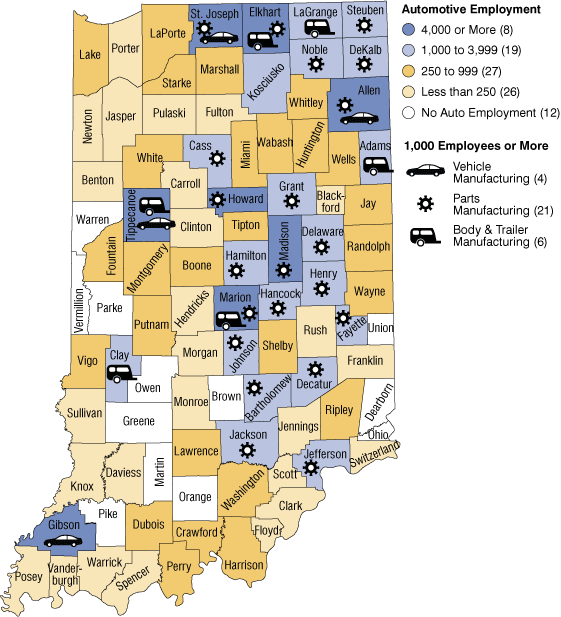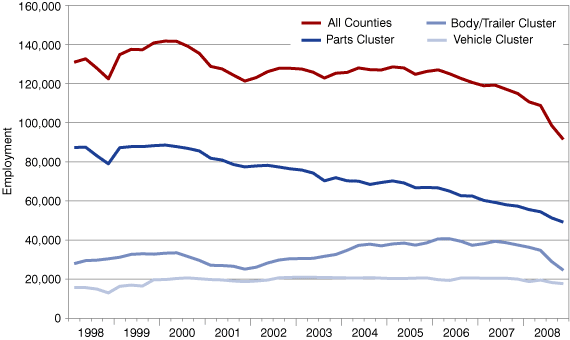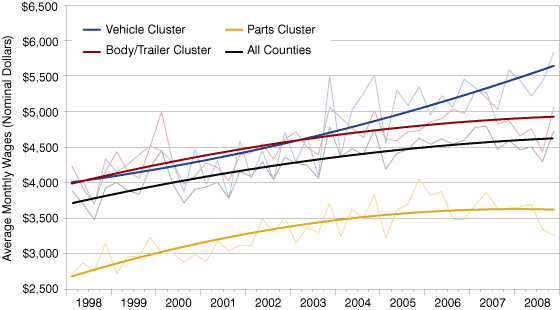Segmenting Indiana's Automotive Manufacturing Industry: Jobs and Wages
When we think of automotive manufacturing, we often focus on the final product such as the car, truck or recreational vehicle we may purchase. What we may overlook is that most economic activity and employment in this industry are “upstream” of the original equipment manufacturers (OEMs) since body and trailer manufacturers and particularly parts manufacturers are the larger direct employers. This article summarizes current employment and the major employers in this industry and its three major sub-sectors across Indiana counties. It then compares employment and wage trends over the 1998 to 2008 time period, by grouping counties into three clusters according to their mixtures of employment in the three major auto industry segments. We find that while counties with predominantly parts manufacturing workers are experiencing decreasing employment and depressed wages, counties with relatively high proportions of workers in full vehicle manufacturing actually have steady employment and real wage growth. Counties that focus on the manufacture of motor vehicle bodies and trailers (including recreational vehicles) experience volatile employment patterns that seem highly dependent on national recession cycles.1
Indiana’s Automotive Industry
Of Indiana’s 102,000 automotive manufacturing workers in 2008, the majority (58 percent) were employed in the motor vehicle parts manufacturing sub-sector (NAICS 3363) at companies that do not produce complete vehicles but focus on component parts. Most of the remaining 30,349 workers (29.6 percent) worked at companies that build trailers or vehicle frames (NAICS 3362). Only 12,720 workers (12.4 percent) were employed in companies that produce complete motor vehicles (NAICS 3361).2
Table 1 summarizes the biggest employers in each of the three major automotive manufacturing sectors and we see that the top four parts manufacturers are also the four largest employers overall. Among these, the largest employer by far is Cummins in Columbus who is the world’s largest manufacturer of heavy diesel engines with over 34,000 workers in Indiana and annual revenues of over $10 billion.3 Other major parts producers include three other major employers in or near the Indianapolis Metropolitan Area: Firestone Diversified Products in Marion County, as well as Remy International Inc. and Remy Inc. of Madison County. Elkhart County, widely regarded as the “RV Capital of the World” has all five of the top body and trailer manufacturing companies in Indiana, including Forest River (5,850 employees) which is the fifth largest automotive manufacturing company overall. Meanwhile, the two biggest employers that manufacture complete auto vehicles are Toyota Motor Manufacturing with 4,300 employees in Gibson County and Subaru of Indiana Automotive with over 2,800 employees in Tippecanoe County.
Table 1 : Top Automotive Manufacturing Employers in Indiana by Sub-Sector, 2008-2009
| Rank | Company | Main Location City (County) |
Employees |
|---|---|---|---|
| Motor Vehicle Parts Manufacturing (NAICS 3363) | |||
| 1 | Cummins Inc. | Columbus (Bartholomew) | 34,900 |
| 2 | Firestone Diversified Products LLC | Indianapolis (Marion) | 11,300 |
| 3 | Remy International Inc. | Anderson (Madison) | 7,971 |
| 4 | Remy Inc. | Pendleton (Madison) | 6,800 |
| 5 | United Components Inc. | Evansville (Vanderburgh) | 4,900 |
| Motor Vehicle Body and Trailer Manufacturing (NAICS 3362) | |||
| 1 | Forest River Inc. | Elkhart (Elkhart) | 5,850 |
| 2 | Supreme Corporation | Goshen (Elkhart) | 2,200 |
| 3 | Jayco Inc. | Middlebury (Elkhart) | 1,770 |
| 4 | Skyline Corporation | Elkhart (Elkhart) | 1,300 |
| 5 | Gulf Stream Coach Inc. | Nappanee (Elkhart) | 1,200 |
| Motor Vehicle Manufacturing (NAICS 3361) | |||
| 1 | Toyota Motor Manufacturing Indiana Inc. | Princeton (Gibson) | 4,300 |
| 2 | Subaru of Indiana Automotive Inc. | Lafayette (Tippecanoe) | 2,813 |
| 3 | AM General LLC | South Bend (St. Joseph) | 1,599 |
| 4 | Utilimaster Holding Co. | Wakarusa (Elkhart) | 1,100 |
| 5 | Crossroads RV | Topeka (LaGrange) | 600 |
Note: Figures reflect different fiscal years according to each company. Available data do not include Honda Manufacturing of Indiana (Greensburg, Decatur County).
Source: Hoover’s Inc.
Employment in the automotive manufacturing industry is thus broadly distributed across Indiana though particularly dominant in the northeastern region of the state near Michigan—the hub of the American automobile industry (see Figure 1). Between 1998 through 2008, only 12 of Indiana’s 92 counties had no employment in this industry while most counties had at least 250 workers; Eight counties—Allen, Elkhart, Gibson, Howard, Madison, Marion, St. Joseph and Tippecanoe—averaged more than 4,000 automotive workers each year.4 While most counties’ auto workers are employed with parts manufacturers, six counties including three northeastern counties—Adams, Elkhart and LaGrange—had over 1,000 workers employed in body and trailer manufacturing. Only four counties had more than 1,000 workers employed in complete vehicle manufacturing including Gibson and Tippecanoe counties, home of Toyota and Subaru plants, respectively.5
Figure 1 : Average Annual County Employment in Automotive Manufacturing, 1998-2008

Source: Hoover's, Inc.; Dun & Bradstreet; and U.S. Bureau of Labor Statistics
Understanding Employment and Wage Growth by County Automotive Manufacturing Cluster
This research uses cluster analysis to divide Indiana’s 80 counties with employment in the automotive manufacturing industry into three major clusters to better understand their employment and wage trends (see Table 2).6 While many counties have employment in at least two of the three major sub-sectors of the industry, the 63 counties in the large parts cluster have almost their entire auto manufacturing workforce—typically more than 95 percent but at least 70 percent—employed in parts manufacturing. The 12 counties in the body/trailer cluster are also highly specialized due to their predominantly high employment in body and trailer manufacturing (usually over 90 percent). The body/trailer cluster counties are: Adams, Benton, Clark, Clay, Daviess, Elkhart, Jasper, Kosciusko, LaGrange, Rush, Switzerland and White. Only employment in the five vehicle cluster counties is fairly diverse since these counties (Allen, Gibson, Randolph, St. Joseph and Tippecanoe) merely have high proportions of their auto employment (more than 40 percent) in the manufacture of complete motor vehicles but still have substantial amounts of employment in body and trailer manufacturing (16.5 percent) and parts manufacturing (26.6 percent).7
Table 2 : Summary of County Automotive Manufacturing Clusters, 1998-2008
| Cluster Name | Employment Criteria | Number of Counties | Average Percentage Employment by Automotive Employment Sub-Sector | ||
|---|---|---|---|---|---|
| Motor Vehicle (complete) | Motor Vehicle Body & Trailer | Motor Vehicle Parts | |||
| Vehicle | Employment in NAICS 3361 of 40 percent or more | 5 | 57.0% | 16.5% | 26.6% |
| Body/Trailer | Employment in NAICS 3362 of 65 percent or more | 12 | 0.1 | 90.4 | 9.5 |
| Parts | Employment in NAICS 3363 of 70 percent or more | 63 | 0.3 | 3.6 | 96.0 |
Note: 12 of Indiana’s counties did not have automotive employment during the 1998-2008 period. This includes Greene County which only had a small number of automotive workers at the beginning of the period.
Source: Hoover's, Inc.; Dun & Bradstreet; and U.S. Bureau of Labor Statistics
Employment by Automotive Manufacturing Cluster
Employment in the automotive manufacturing industry is perceived to be both volatile and on a downward trend. A close look at Figure 2 though compounds this overall theme since we see that volatility is primarily a feature of counties in the body/trailer cluster and the vehicle cluster counties have remarkably steady employment. Over the 1998-2008 period, statewide auto worker employment reached to a peak of 141,700 workers in the first quarter of 2000, and despite holding steady between 120,000 and 130,000 workers from 2001 to 2006, dropped precipitously to 91,500 workers by the end of 2008 and is likely to have declined further in 2009 as the U.S. recession continued. However, during this period, employment in the vehicle cluster counties was virtually constant at approximately 20,000. Employment volatility is more noticeable in the body/trailer cluster counties, due in large part to the cyclical nature of recreational vehicle retail sales , with higher levels of employment after the 2001 recession to a high of 40,000 workers by 2006 and a very sharp decline entering the 2008-2009 recessionary period. Finally, employment in parts cluster counties seems to be responsible for most of the state’s job loss in the automotive manufacturing industry dropping steadily almost regardless of recessionary cycles from near 90,000 workers through 2000 down more than 40 percent to only 49,200 by the end of 2008.
Figure 2 : Indiana Employment by County Automotive Manufacturing Cluster, 1998:1 through 2008:4

Note: Hash marks indicate quarters of each year. This chart uses combined employment data for motor vehicle manufacturing (NAICS 3361), motor vehicle body and trailer manufacturing (NAICS 3362), and motor vehicle parts manufacturing (NAICS 3363). The 80 Indiana counties that have employment in these sectors have been divided into these three clusters based on their similarities.
Source: Hoover's, Inc.; Dun & Bradstreet; and U.S. Bureau of Labor Statistics
Wages by Automotive Manufacturing Cluster
Even in nominal terms, wage growth in the automotive manufacturing industry has been flat in Indiana and trending downward between 1998 and 2008 (see Figure 3). The big exception to this pattern is the accelerating wage growth experienced by workers in the vehicle cluster counties whose monthly wages grew from $4,000 at the start of 1998 to over $5,500 by 2008—a 38 percent increase that reflects real growth in inflation-adjusted wages as well. Although the wages of workers in body/trailer cluster counties were similar to workers in vehicle cluster counties in 1998, their wages grew slowly with a downward trend over this period, increasing less than $1,000 over the 10-year period.
Figure 3 : Average Monthly Wages per Worker by County Automotive Manufacturing Cluster, 1998:1 through 2008:4

Note: Hash marks indicate quarters of each year. This chart uses combined employment data for the motor vehicle manufacturing (NAICS 3361), motor vehicle body and trailer manufacturing (NAICS 3362) and motor vehicle parts manufacturing (NAICS 3363). The 80 Indiana counties that have employment in these sectors have been divided into these three clusters based on their similarities.
Source: Hoover's, Inc.; Dun & Bradstreet; and U.S. Bureau of Labor Statistics
However, the most startling lack of wage growth was demonstrated by workers in the parts cluster counties whose relatively low monthly average wage of approximately $2,500 grew only anemically through 2007 and in 2008 started showing signs of decline even in nominal terms. Some of this worsening wage trend can be explained by parts manufacturing jobs moving away from the Midwest to Southeastern states and by differing cost structures for suppliers to the Detroit Three automakers (General Motors, Ford and Chrysler) compared to foreign automobile manufacturers.8 More simply, the fact that parts cluster counties are experiencing rapidly declining employment (as seen in Figure 2) indicates that there may be a glut of labor supply versus actual demand for employment which could significantly depress wages.
Silver Lining to the Pattern of Decline
Overall, this article reveals that Indiana counties are experiencing lower levels of employment and stagnating levels of wage growth in the automotive industry but these trends are not constant within the differing segments of the industry. The fact that parts cluster counties continue to show a rapid decline in employment and decreasing wage growth means that the overall automotive industry is likely to continue to decline in Indiana since the vast majority of automotive workers are employed within the parts sub-sector. Many parts manufacturing workers will simply have no choice but to re-train and take advantage of new job opportunities, such as those in chemical manufacturing, the life sciences or a host of newly-defined “green” occupations.
However, vehicle cluster and body/trailer cluster counties seem to have substantially different patterns in their employment and wage outcomes compared to the rest of the state. Bucking overall trends, the five counties in the vehicle cluster have shown remarkably steady levels of employment and wage growth between 1998 and 2008. Decatur County is likely to become the sixth county to join this cluster due to the recent opening of the Honda manufacturing plant and this has the potential of boosting employment and wage levels there and perhaps elsewhere in the state. Although the body/trailer cluster counties have recently experienced tremendous employment losses—notably Elkhart County, which briefly had the highest unemployment rate in the nation in 2009—their employment is poised to rebound (as it did between following the 2001 recession) as the U.S. economy improves in 2010 and 2011.
Endnotes
- In recent related research, we reviewed key factors that influence employment and GDP growth in the automotive manufacturing industry across the 48 contiguous states. GDP growth was found to be directly linked to increased revenues of the U.S. automakers between 1998 and 2008. Furthermore, despite the global nature of the automotive industry, state level employment in the automotive sector (especially the parts manufacturing subsector) was positively linked to the performance of the U.S. carmakers but inversely to Japanese carmakers. This was generally true, except in the case of Toyota, whose tremendous recent growth had no measurable impact on state-level automotive GDP or employment. This research is in: “Employment and Economic Growth in the U.S. Automotive Manufacturing Industry: Considering the Impact of American and Japanese Automakers,” Indiana Business Review 85: 1 (Spring 2010), www.ibrc.indiana.edu/ibr/2010/spring/article2.html.
- These figures come from the U.S. Bureau of Labor Statistics and more information on the North American Industrial Classification System (NAICS) can be found at www.census.gov/cgi-bin/sssd/naics/naicsrch?chart=2007.
- This information comes from analysis of Cummins Inc. 2009 annual reports conducted by Hoover’s Inc.
- These calculations use data from the U.S. Bureau of Labor Statistics. Greene County had a small amount of employment during the 1998–1999 but no employment was recorded for the rest of this period.
- The fact that Allen and St. Joseph counties had over 1,000 employees in motor vehicle manufacturing even though they do not contain large plants that do complete vehicle manufacturing suggests that employees may reside in those counties but commute to work at facilities in neighboring counties.
- These clusters were determined by a (k)-means cluster analysis procedure that divided counties into three clusters based on their similarity/dissimilarity (via Euclidean distance) according to their relative proportion of employment in each of the three automotive manufacturing clusters.
- Decatur County is categorized here as belonging to the parts cluster and not the vehicle cluster because Honda Manufacturing of Indiana’s plant in Greensburg was not in full operation until after the 1998-2008 time period.
- This information comes from: Benjamin Collins, Thomas McDonald, and Jay A. Mousa, “The Rise and Decline of Auto Parts Manufacturing in the Midwest,” Monthly Labor Review 130, no. 10 (2007): 14-20.
Michael F. Thompson
Economic Research Analyst, Indiana Business Research Center, Indiana University Kelley School of Business
Ali Arif Merchant
Research Assistant, Indiana Business Research Center, Indiana University Kelley School of Business
